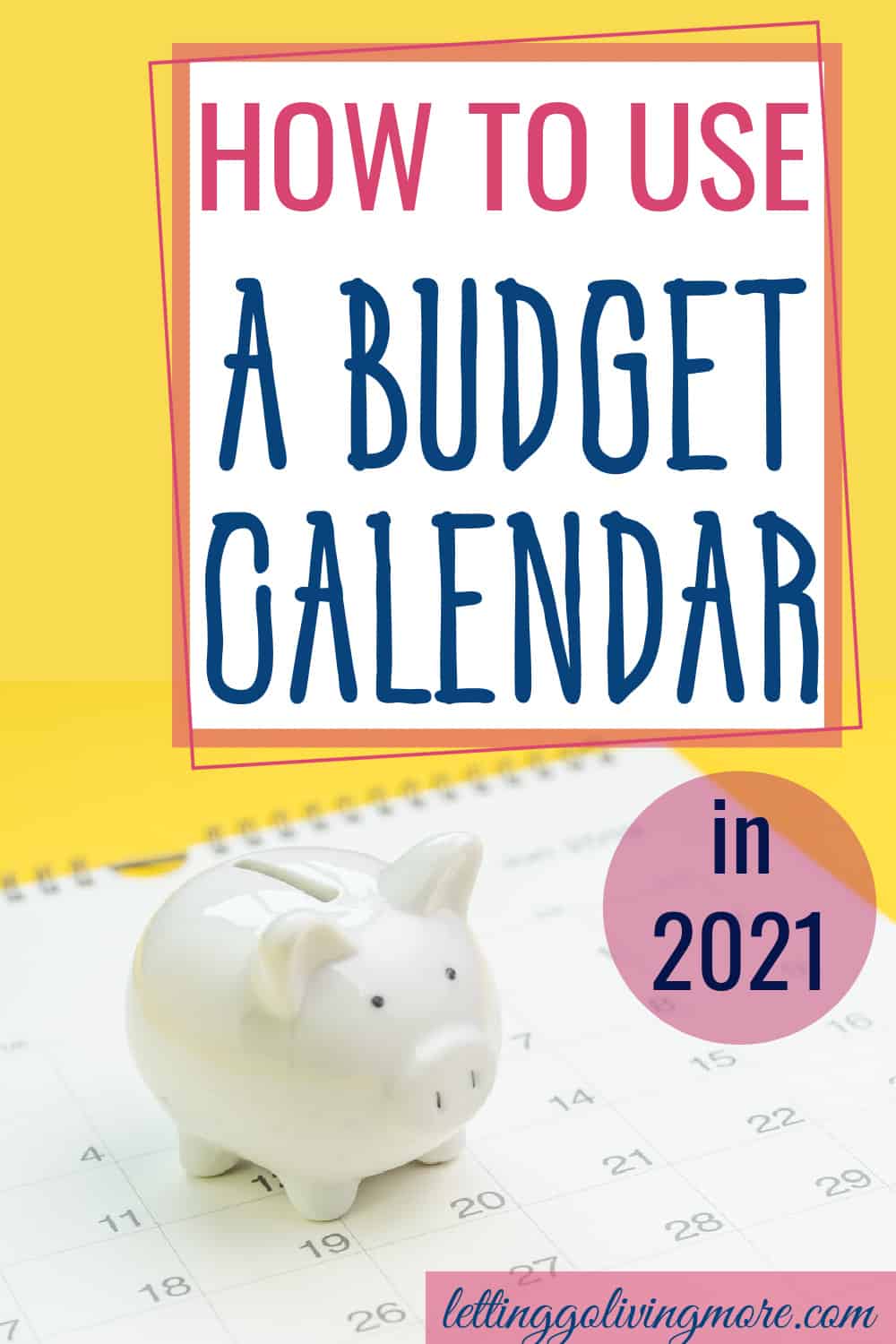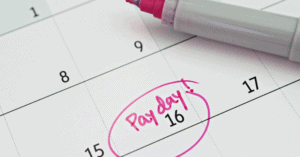If you have tried several times to keep to a budget, but still find yourself wondering where your money has gone at the end of the month, then a budget calendar could be for you. Whilst it can be useful for anyone, a budget calendar is especially helpful if you are living paycheck to paycheck.
I started using a budget calendar to keep track of when I needed to make payments back when there was no autopay for bills (I’m not even that old, but that makes me sound really ancient!).
Now, even though most of my bills and payments are set to come out of my bank account automatically, I still have everything written on a budget calendar so I know exactly what is happening with my finances.
- What is a budget calendar?
- Why should you use a budget calendar?
- How to create a budget calendar
- Step 1: Buy a calendar
- Step 2: Gather all of your income and bill details
- Step 3: Work out your other necessary spending
- Step 4: Make your list and check you have enough each month for your outgoings
- Step 5: Adjust as needed
- Step 6: Put all of your paydays into the calendar
- Step 7: Put all of your bills onto the calendar on their due date
- Step 8: Put your other necessary spending onto the calendar on the relevant dates
- Step 9: Add other special occasions where you need to spend money
- Step 10: Set up color coding for your income and expenses
- Maintaining your budget calendar
- Is a budget calendar right for you?
This post may contain affiliate links. That means if you click and buy, I may receive a small commission (at zero cost to you). As an Amazon Associate I earn from qualifying purchases. Please see my full disclosure policy for details.
What is a budget calendar?
Let’s start by looking at what we mean when we talk about a budget calendar (which is sometimes also called a calendar budget). The budget calendar shows the money you expect to have coming in and the money you know will be going out.
Your budget calendar can be done weekly, monthly or even yearly, depending on your preferred calendar view. It can also be created using a wall calendar, a desk calendar or even a digital calendar.
It is a pretty simple concept – you normally use your calendar to remember important appointments and events. The budget calendar helps you to see each of your financial commitments in calendar form, like any other important event, which means you can plan for them well in advance.
Why should you use a budget calendar?
A budget calendar gives you all of your finances at a glance
A budget calendar is a good way to see your future income and spending on a page, which is helpful if you are one of those people who tends to run out of money before your next paycheck because you didn’t know what you were going to need to spend.
I find a budget calendar to be really useful for knowing where my finances are at. If it is the middle of the month and I have $200 left in my account, I can look ahead to know exactly what bills and payments I need to make before my next paycheck is due.
A budget calendar is also a great way to remember any bills that are coming up which are not on autopsy. This helps to avoid any late fees which are a huge waste of money, particularly when you are working with a tight budget.
A budget calendar is useful for visual people
I also really like the way a budget calendar looks. I’m quite a visual person, and I know there are plenty of people who hate the idea of trying to track their budget in a spreadsheet. The budget calendar is colorful and is a really easy way to see your finances in a format that is easy on the eye, and so much nicer than a page of numbers!
A budget calendar is great for planning and saving
Having the budget calendar hanging up where I can see it is also useful to keep on track with my financial goals. When a budget is hidden away, it can be easy for it to be out of mind, and goals to get forgotten. When a colorful budget is stuck on the wall and I am looking at it every day, it encourages me to take it in, and keep thinking about how I am spending my money, and where I can make more savings.

How to create a budget calendar
I have set out the steps below that I follow when setting up my budget calendar – this is just how I do it, and you may choose to do things differently if you think there is another way that will work better for you.
If you find all of the steps for working out your expenses to be overwhelming, then cut it back. Start by just doing paychecks and your known bills with due dates. You can add more to the calendar once you get used to using a budget calendar. It’s better to start small and grow your budgeting calendar than to give up at the start because it all seems too hard.
Step 1: Buy a calendar
My favorite calendars for the budget calendar are the month by month calendars with big boxes for writing in the commitments for each day. I like this wall calendar as it is a good size and inexpensive. If you prefer, then get a week by week calendar.
If you are on a tight budget, you don’t need to buy a calendar. You can usually find free printable calendars for calendar budgeting on Pinterest, or even grab a ruler and a pen and make your own.
Step 2: Gather all of your income and bill details
The next step is to make a list of your known income. Usually that will just be your paycheck, but if you have any other income that is regular and known, like income from a rental property, you can include that too.
If you have income that is not certain (such as occasional overtime or a bonus) my advice is not to include this, as you may be left short of money if that income doesn’t come in.
Once you have listed your income, make a list of your known bills and the date (or dates) the bill is due. This includes things like rent, any minimum payments on debt and credit cards, health insurance, vehicle registration etc.
If your bill is an annual expense, I suggest you write down the due date but come back to it later to work out when you’ll be putting money aside to make sure you can pay it.
Step 3: Work out your other necessary spending
Other necessary spending are things like groceries, medical bills, clothing, haircuts, fuel, car maintenance, pet food, and vet bills. It’s easy to forget the general spending items, but I find it’s best to plan for everything you need to keep your household running. These are things like cleaning products, toiletries and beauty items, laundry detergent, lightbulbs, batteries, kitchen foil, cling wrap, and garbage bags.
If you have no idea what your expenses are, then the best way to work out where to start is to look at your online banking, bank statements or credit card statement. You should be able to see how much you have been spending at the store in the last 3-6 months and that gives you a pretty good idea of your general household spending.
Don’t forget the little things like your daily/weekly cafe stop on the way to work, or your mid-afternoon coffee, or your weekly trip to the liquor store. These add up quickly, and unless you have already proven to yourself you can give them up, they need to go on the list as current expenses.
I find it is best to start by putting into your budget calendar the approximate amounts that you are currently spending. Even if you think you spend too much on groceries now, if you only put $100 in each week of your budget calendar and you currently spend $200, you’re likely to fail early on and give up. Check out this article if you want to know what you should be spending on food.
Also, if you’re worried you may have missed some expense items for your budget calendar, check out my budget spreadsheet on the right side of this page, which has pretty much every category of spending you can think of! Using this would also be a great way to organize all of your spending and check expenses before you put them onto the calendar.
Step 4: Make your list and check you have enough each month for your outgoings
Check that your income for each month of your budget calendar is more than your expenses, and note any months when your paycheck is not going to cover the expenses that you will have for that month. This might happen if you have a bill that you need to pay once a year to cover the whole year.
Where you have a bigger bill due, if you have left over in the month(s) before, then add in an expense item for “bills fund” or something similar to go into your budget calendar, and make sure you move that extra money to a savings account or separate account. You can then bring money from that account to pay the bills that you have identified won’t be covered by the paycheck for that month.
If you have enough to cover all of your expenses, and you want to get more detailed with your expenses in your calendar budget, you might also want to list out your fun money and savings expenses (assuming you have money left over for these). Fun money is something we allocate to spend however we want, and we each get some fun money of our own. So things like the cinema are not anywhere in my normal budget calendar, but I might choose to spend my fun money one month on a trip to the cinema.
With savings, if you can, then list out some money every month which you need to transfer to savings. You may have a specific savings goal, like a down payment on a house, or a holiday. Otherwise, you might want to put an amount on your budgeting calendar for retirement savings using a Roth IRA or another type of retirement account.
Step 5: Adjust as needed
If you are not going to have enough in each paycheck to pay your bills, then you need to look at reducing your expenses or increasing your income. The following should be done immediately if you are currently spending more that you are earning. Otherwise, make a note in your budget calendar to review one of them each week or month and reduce your spending over time.
Easy ways to reduce expenses include looking for unnecessary subscriptions. For example, do you have cable, Netflix, Hulu and Amazon? If so, choose to get rid of one of more of these subscriptions.
Another easy way to look to reduce bills is to call your providers and ask for a better deal. Lots of companies offer better deals to new customers than existing customers. So call around and make sure you have the best deal with your current provider, or otherwise be ready to change to a provider that will give you a better offer.
Step 6: Put all of your paydays into the calendar
Now we have worked through the income and expenses, it’s time to start filling in the budget calendar. Start by putting all of your pay days into the budget calendar and the amount you are going to be paid. Also add in any other certain income that was in your list, and the date that you will receive it.
Step 7: Put all of your bills onto the calendar on their due date
Write each of your bills in your budget calendar on or before the due date (e.g. if you have to mail a check, I would put it on the mailing date so that I remember to do it!). Write the name of the bill or expense and the amount (e.g. RENT $500).
Step 8: Put your other necessary spending onto the calendar on the relevant dates
The next step is to include all of your other necessary spending in your budget calendar. If you usually go to the grocery store on a Saturday, then put your grocery amounts each Saturday.
If you have grouped together all of your necessary items from the grocery store like cleaning products and toiletries, then just make sure you have spread out buying them over the year so you don’t start with a huge grocery bill in your first month.
Step 9: Add other special occasions where you need to spend money
The last step is to add in those other occasions where you know you will be spending money. Family birthdays, weddings and vacations are all extra expenses that you should have in the calendar.
For gifts, I usually put the purchase of the gift in the month prior to the event, and then the event itself in the calendar on the actual date.
With vacations, I work out how much I will need for the holiday first. Then I have a monthly amount going to the “bills fund” or “vacation fund” so that I have enough saved up for when the holiday comes around.
Step 10: Set up color coding for your income and expenses
Now that all of your income and expenses are in the calendar, it’s time to start color coding your calendar.
When making a paycheck budget, you can color code each payday a different color, and then color the bills and expenses to be paid from that paycheck in the same color as the paycheck.
If you are coding income and expenses by person, then you might color all of your income and expenses green, and your partner/roommate’s income and expenses orange.
Perhaps you want to keep track of different types of expenses. In this case you can color code each type the same e.g. color your paychecks blue, your rent pink, your groceries green. You might also highlight income one color, expenses another color, and savings another color.
You can color code your budget calendar however you like. The main thing is that the color coding makes sense to you and helps you to keep on track with your budgeting.
Maintaining your budget calendar
Your budget calendar is no different to any other type of budget, in that you do need to keep reviewing it to check it is working.
When do I need to review my budget calendar?
If you are amazing at sticking to a budget, you may only need to review your budget calendar every three months or six months. If you’re not so good at keeping on track, then go for a weekly or monthly check in to make sure you are not overspending or missing some expenses on your budget calendar.
When do I need to make changes to my budget calendar?
You may need to review and make adjustments if you find you are spending more than you think. Go back to the ideas above for how to adjust spending and cut expenses. You may also need to adjust if you find you have unexpected expenses cropping up every month, and so need to put more aside to manage the expenses.
You will also need to adjust if you have life changes occurring, for example, if a partner or roommate moves in or moves out, or if you have a change in your income.
Is a budget calendar right for you?
When it comes to getting your budget under control, there is no right or wrong way to do it. You need to find a method that works for you, and sometimes the only way to do that is by trial and error. I suggest giving the budget calendar a really good try for 3 to 6 months to get into the groove and see if it starts to click.
Otherwise, if a monthly budget with a tracking spreadsheet is more aligned to your way of thinking, head on over to my article about how to create a budget, or directly download the free budgeting spreadsheet.
Sharing is caring!






